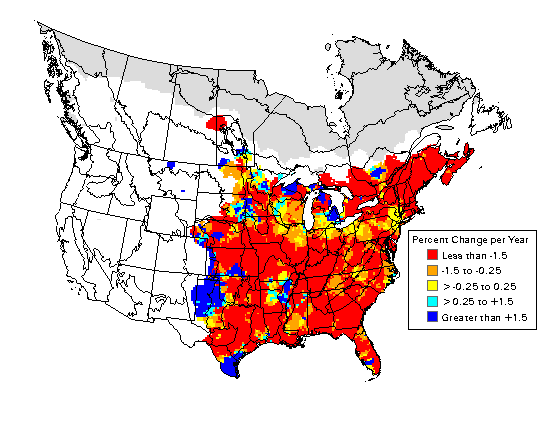

DR. CHRISTY MORRISSEY
Understanding causes of aerial insectivore declines
Aerial insectivorous birds, including such harbingers of spring as swifts and swallows, are experiencing dramatic population declines. Aerial insectivore population declines are significantly stronger and more prevalent than other songbirds, with 85% of the species in his guild declining. Though numerous causes have been proposed such as agricultural pesticide use and climate change to changes in insect prey, the species specific drivers and mechanisms of these declines remain unknown...
Role of Agricultural Land use practices
Coincident with the declines of aerial insectivorous bird species is the introduction of practices associated with intensive agriculture. Populations associated with intensive agriculture with more pesticides and other agrochemicals, drained wetlands and more intensively managed crops, may be vulnerable. Intensive agricultural practices can reduce nesting habitat and food resources, which may in turn affect the birds ability to successfully survive and reproduce . Insect abundance and diversity has been shown to be lower in areas using intensive agricultural practices.
We have projects assessing the effects of agriculture and neonicotinoid use on the Tree swallow, a model aerial insectivore whose reproductive ecology is well studied allowing for the hypotheses of indirect effects to be tested in depth. The specific projects include:



1) Impact of agricultural intensification on the diet, condition and reproductive success of an aerial insectivore, the Tree swallow
MSc Student: Chantel Michelson
This study is evaluating whether agricultural intensification affects Tree swallow diet and reproductive success, adult and nestling body condition during the breeding season. We are exploring whether observed changes in the birds can be attributed to shifts in diet between agricultural and grassland sites as evidenced by stable isotope ratios in blood samples. We are also testing whether diet differences exist between adults and nestlings as this may indicate a fitness trade-off between adult survival and reproductive output- information that is key to understanding population declines.
2) Indirect effects of agricultural intensification on Tree swallow (Tachycineta bicolor) foraging behaviour, body condition, and physiology
MSc student:: Rebecca Stanton
Reductions or changes in food supply prompted by agricultural intensification may in turn cause an increase in adult foraging effort. Reduced food availability, together with the increased foraging rate should lead to an increase in oxygen consumption, which may lead to higher production of pro-oxidants and lower levels of exogenously-derived antioxidants. This imbalance has the potential to cause oxidative stress, which may impact survival and life history traits. We are elucidating the relationship between indirect effects of insecticide use and agricultural intensification on Tree Swallow physiology and foraging behaviour across different sites in central Saskatchewan.
Exploring intercontinental population patterns and climate and landuse drivers
Interestingly, aerial insectivores exhibit distinct spatial and temporal patterns in population trends. Persistent declines were first observed in the mid-1980s for most species. Populations in northeastern United States and eastern Canada exhibit the strongest declines, and long-distance migrants such as Chimney Swifts are declining more rapidly than short-distance migrants such as Tree Swallows.

Postdoctoral fellow: Nicole Michel
Aerial insectivorous bird declines are commonly attributed to abundances of their flying insect prey. Yet while reduced insect abundance may be a proximate mechanism of decline, insects themselves are susceptible to a variety of global change drivers. Altered temperature and rainfall regimes, land use change, and pesticides are just a few factors that influence insect abundance. Moreover, these same drivers impact aerial insectivorous birds directly. For example, temperature changes can induce heat or cold stress, or land use change can reduce availability of preferred nesting or foraging habitat.


Therefore, we are investigating the pattens of declines among 5 different species of swallows and swifts using the North American Breeding Bird Survey data over 30 years to determine whether there is any spatial or temporal overlap in the observed population trends (Michel et al. 2015 Ecography). Following from that work, we are examining how multiple global change drivers are affecting those 5 species on a continental scale including the breeding, wintering and migratory periods. The effects of climate such as storm intensity and frequency, temperatures and precipitation alongside changes in land use are important drivers of trends. Our work however, indicates each aerial insectivore species is faced with unique trends and challenges that are better assessed independent of guild level conservation assumptions about common underlying drivers.
Barn Swallow (Hirundo rustica) population trend, 1966-2011 showing variable trends but with strongest declines in the north and west. Source USGS Breeding Bird Survey
Chimney swift population trend, 1966-2011 showing strong declines in most of range but strongest in the south-east.
Source USGS Breeding Bird Survey